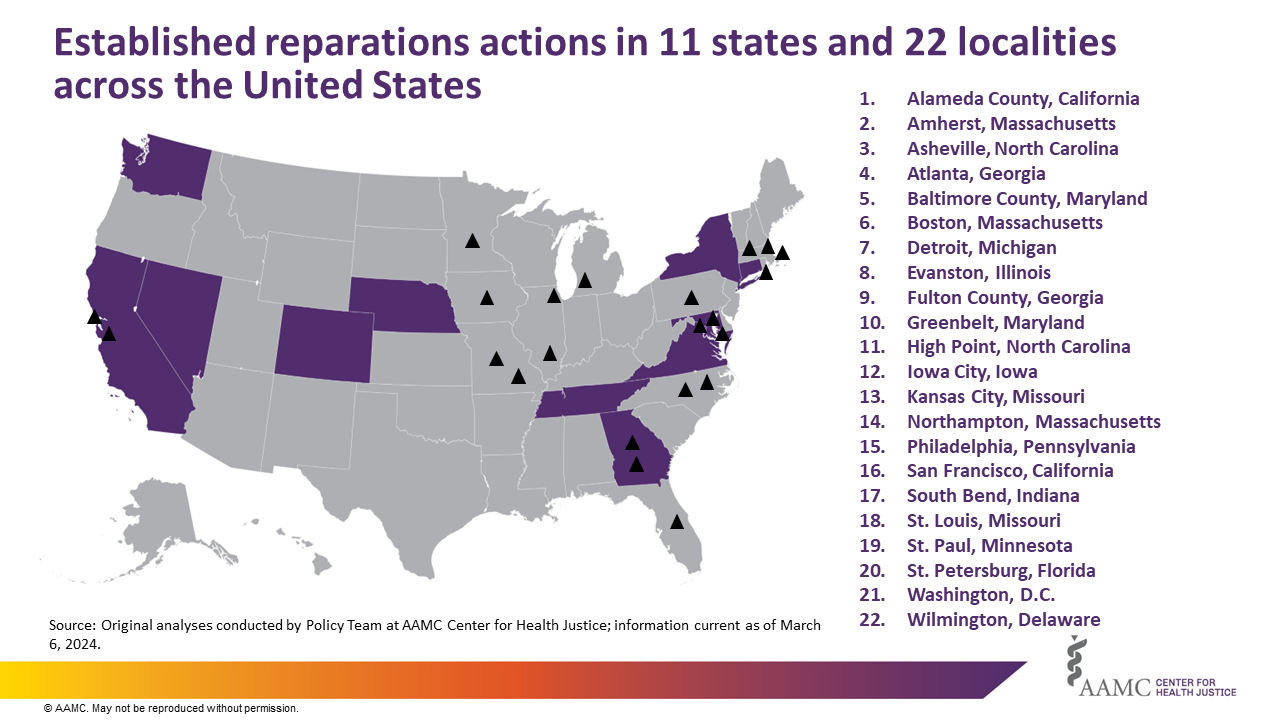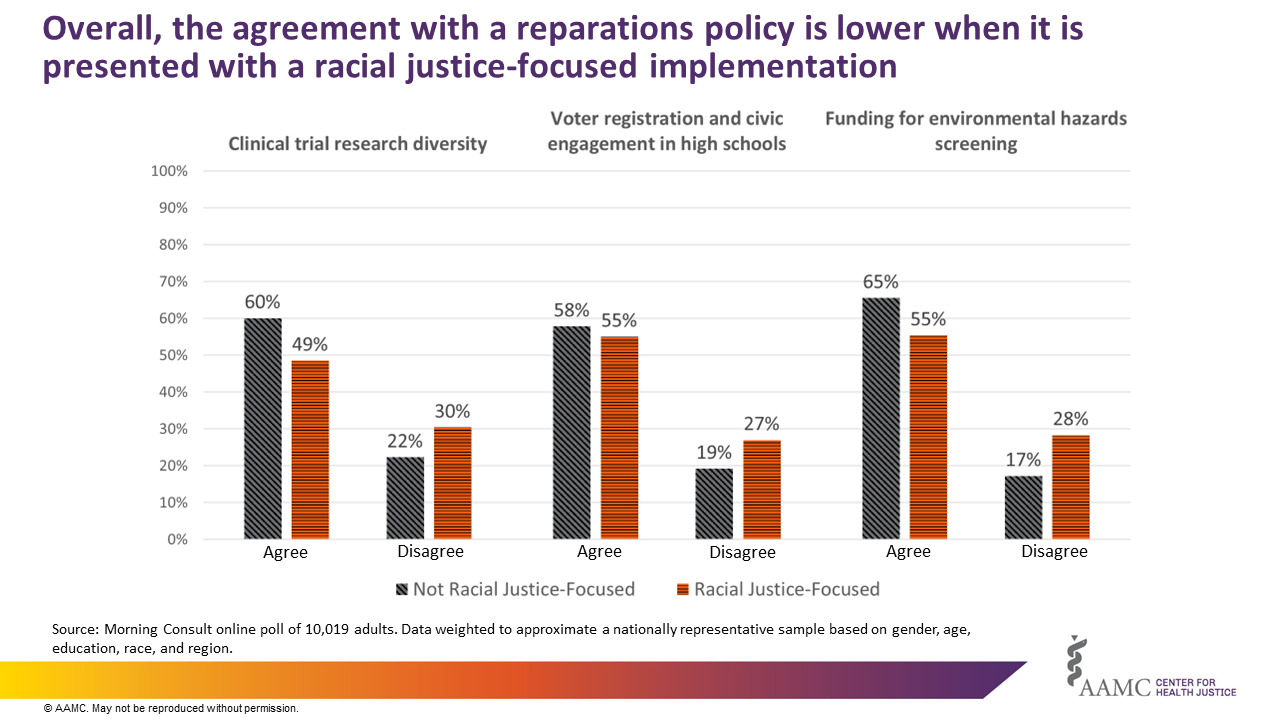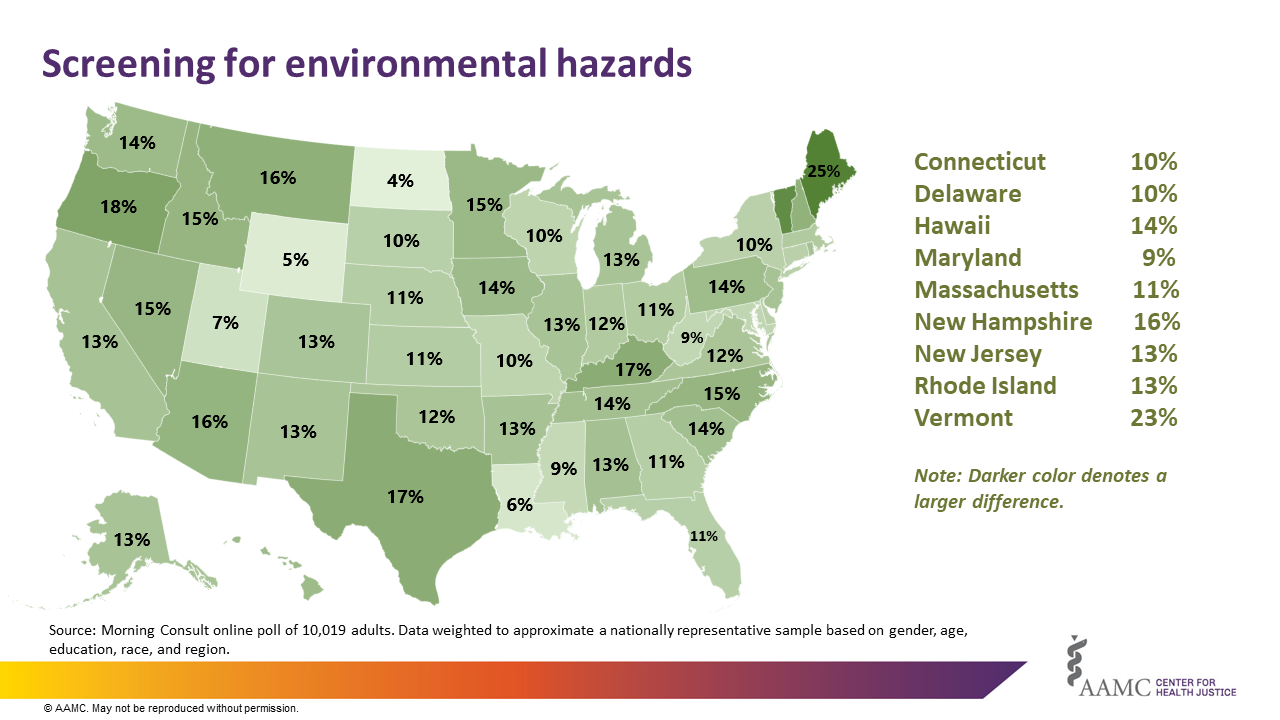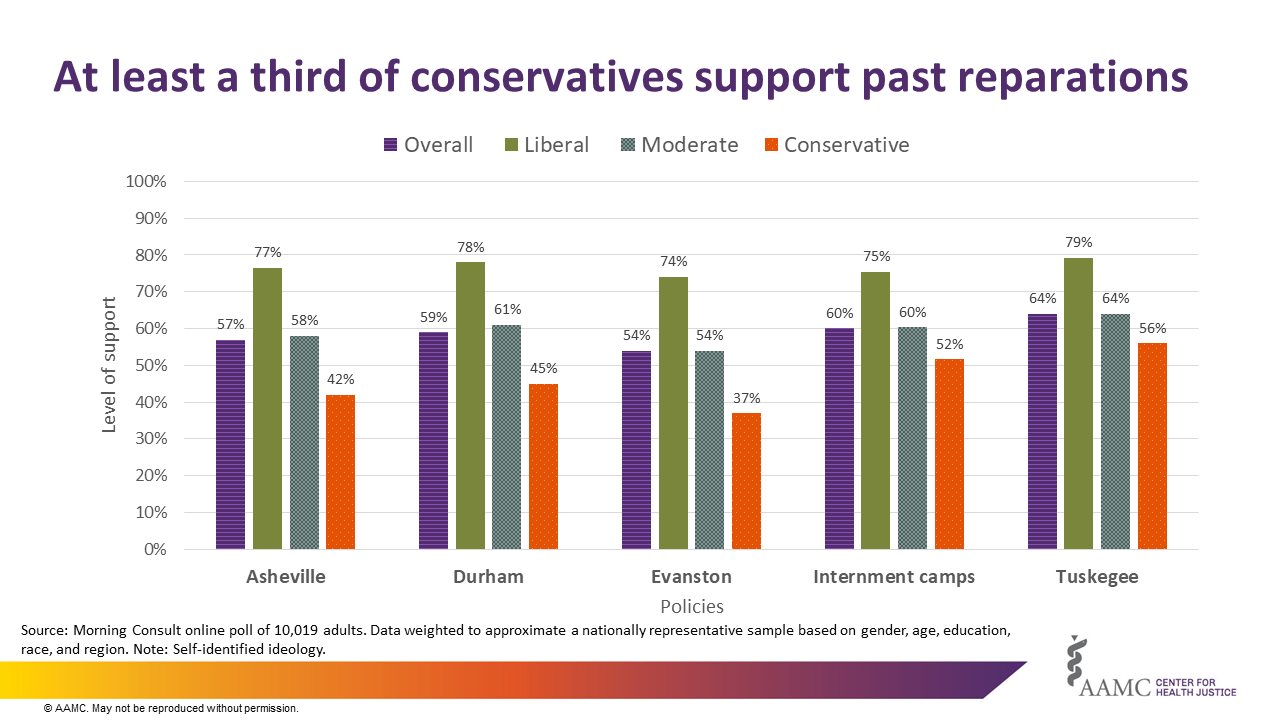The issue of reparations for the descendants of people enslaved in the United States has gained attention over the past decade and a half, sparked by notable events such as the unprecedented apology for slavery and Jim Crow laws1 by the U.S. House of Representatives in 2008,2 followed by a similar resolution unanimously passed in the U.S. Senate in 2009.3 Other events, such as national demonstrations for racial justice (e.g., Black Lives Matter movement) and the murder of George Floyd and other Black and African American people by police,4 have also intensified public demands for acknowledgment of the historical and ongoing effects of slavery and Jim Crow laws on Black and African Americans and the broader U.S. society.
A Growing Movement for Reparations
As of March 6, 2024, 22 localities (including Washington, D.C.) have approved a reparations commission or task force and 11 states have introduced legislation to create one (Figure 1). In October 2020, California passed the first law in the nation to create a reparations task force to study and develop proposals for redressing injustices experienced by African Americans in the state, with special consideration for descendants of people enslaved in the United States.5 Recently, over 400 activists, lawmakers and others urged President Biden to support through executive action Congressional bills on racial equity and reparative justice.6
Surveying U.S. Adults’ Perspectives on Reparations
In January 2024 the Center conducted a nationally representative survey of U.S. adults (n = 10,019) to gauge levels of support for policies that, if implemented, would have a positive racial justice impact. We were interested in exploring how changing the proposed implementation strategy of these policies — to be more or less racial justice-focused — may affect support. Given that most reparations actions are taking place at state and local levels, our sample allowed for state-by-state analysis.
Support for Policies Included in California’s Reparations Proposal
On June 29, 2023, the California Reparations Task Force issued a landmark report7 of over 115 evidence-based policy recommendations that address a range of topics across the vital conditions for health and well-being.8 These include housing equality, education, civic engagement, health care, environmental justice, and criminal justice.7 The Center selected seven of these policies and surveyed respondents about their level of support. All reflect potential action across diverse vital conditions and several are being considered by state and local reparations commissions or task forces.
- Funding to increase civic engagement and voter registration activities for high school students
- Restoration of voting rights for formerly incarcerated individuals
- Requirements for landlords to accept housing subsidies and vouchers
- Increased public school funding for student needs and educational programs
- Funding for environmental hazard-exposure screenings
- Financial support to assist voluntary participation in clinical trials
- Prohibition on rent increases on run-down apartments or those in need of repairs
Across all U.S. adults, there was strong support (over 60%) for all seven policies tested and notable agreement across political ideologies: Over 50% of conservative respondents expressed support for these policies, which would disproportionately benefit communities of color (Figure 2). Support for these policies did not fall below 60% in any part of the country.
Implementation of Racial Justice-Focused Policies
The survey also asked about respondents’ level of agreement with how policymakers and others might prioritize the implementation of these policies.
For three of the seven tested policies, the survey presented half the respondents with a proposed rollout plan that explicitly prioritized racial justice; the other half responded to a rollout plan that did not. For example, for high school student voter education and registration, the racial justice-focused option proposed “… the rollout should prioritize schools located within predominantly Black and African American communities, where evidence suggests voter turnout tends to be lower due to a history of policies that have restricted voting access for that population.” The other half of respondents were presented with an implementation plan that suggested, “… the rollout should prioritize schools located within so-called ‘voter-turnout deserts,’ which are defined as ‘precincts where turnout is significantly lower than the national average.’ ”
Importantly, all the implementation plans presented to survey respondents would serve to improve racial justice. For example, research shows that minorities are much more likely to live in voter-turnout deserts9 and thus would disproportionately and positively benefit from the second option presented.
The results show that the way in which policies are framed influences agreement. Agreement with racial justice-focused policy implementation was consistently lower and disagreement was consistently higher (Figure 3). However, for two of the three policies (voter registration and environmental hazards screening), the racial justice-focused implementation plan still garnered over 50% support. Racial justice-focused implementation strategies earned more support from Generation Z10 and Black respondents, compared with other demographic groups (data not shown).
In most cases, fewer people agreed with policy implementation plans that were presented with an explicit racial justice focus. However, this difference varied across states and by the type of policy that was being presented (Figures 4, 5, and 6 and supplemental tables). In Pennsylvania, for example, agreement with a racial justice-focused rollout to increase clinical trial diversity was 8% lower than for the non-racial justice-focused option. This difference grew to 14% for environmental hazard screenings but dropped to 0% when it came to civic engagement activities for high school students.
Support for Racial Justice-Focused Versus Not Racial Justice-Focused Policy Implementation Varies by State and Policy
Familiarity With the Term “Reparations” and General Support for Reparations Actions
Respondents were asked whether they were familiar with the concept of reparations, which was broadly defined.11 The results showed that 66% of adults were familiar with the term. Those most acquainted with the concept had higher levels of education (82% of those with a postgraduate education were familiar) and earned higher incomes (79% of those familiar had annual incomes of more than $100,000 per year).
While awareness was high, only 40% of adults in the sample expressed support for providing reparations (38% opposed, and 22% either didn’t know or had no opinion), with notable differences observed by race and generation.
Specifically, 74% of Black respondents expressed support for reparations, compared with 47% of Hispanic respondents, 45% of Asian American/Pacific Islander respondents, and 34% of white respondents. Additionally, younger generations (Generation Z, millennials12) showed higher levels of support (50% or higher for both groups), compared with older generations (only 26% of baby boomers13 expressed support). Majorities in only one state — Maryland (52%) — and the District of Columbia (67%) expressed support for reparations (see supplemental tables). Two-thirds (65%) of those who support reparations believe the federal government should be responsible for making them.
Reasons for Support or Opposition
Among the respondents who supported reparations, several (25%) believed that it was the “right thing to do” to address injustice, while others acknowledged the impact of slavery, its dehumanizing treatment of people as property, or chattel,14 and the ongoing harms it caused (20%). One respondent drew connections between slavery and the resulting injustices African Americans experience today: “I feel that the repercussions of slavery are felt today in many forms of discrimination, such as in housing, education, and salaries. It [reparations] would help to bring descendants of slaves up to parity with others.”
However, among the respondents who opposed reparations, a common belief was that slavery occurred too long ago and so does not impact African American people today (33%). Some also expressed that money is not the solution (18%). As one respondent remarked: “Slavery ended hundreds of years ago. It’s terrible that it happened, but we shouldn’t be focusing on it now.” Another stated that “the damage was not done to them personally.”
Support for Financial Repayment
When presented with a “Yes” or “No” answer choice, 48% of respondents supported providing some type of financial repayment (e.g., educational scholarships, cash payments, financing assistance for starting a business or buying a home, etc.) to African Americans who are descendants of people enslaved in the United States. Black (85%), Asian American/Pacific Islander (56%), and Hispanic (56%) respondents were more supportive of financial repayment than were white respondents (41%). Among those who supported financial restitution, more than half (53%) believed that educational scholarships should be provided. No other form of financial repayment received majority support among those who believe financial repayments should be made.
Real-World Examples of Reparations
Respondents were presented with five examples of other types of reparations that have been given to affected groups in the United States.
- One-time federal cash payments ($20,000) in 1988 to eligible Japanese Americans sent to an internment camp during World War II15
- The Asheville, North Carolina, 2020 commitment of $2.1 million for African American residents16
- The Evanston, Illinois, 2021 reparations law providing funding for African American residents (or their direct descendants) impacted by housing discrimination17
- Award of $10 million and other forms of redress (e.g., medical benefits and burial services) in 1974 to living African American males (and their immediate family members) who were denied medical treatment for syphilis infection during the U.S. Public Health Service Untreated Syphilis Study at Tuskegee18
- The Durham, North Carolina, 2021 commitment of $6 million toward green and equitable infrastructure in historically African American neighborhoods19
There was majority support among U.S. adults for all five real-world examples provided, ranging from 54% for Evanston’s reparations law to 64% for reparations action taken related to the Syphilis Study at Tuskegee. However, majority support among conservative U.S. adults was seen only for reparations related to Tuskegee (56%) and World War II (52%), whereas a majority of their liberal and moderate counterparts supported all five actions (Figure 7). Generational, racial, and ethnic differences also emerged, with younger generations and minority populations more supportive.
Considerations for Advocates and Policymakers
While there is broad public support for policies, like those presented in the California Reparations Report, that would have a racial justice impact, U.S. adults are more likely to approve of implementing such policies when a racial justice goal is not explicitly stated. The idea of reparations, even when broadly defined and not limited to cash payments, is also not supported by the majority of the public, and the more time that has elapsed between a historical injustice and the proposed redress, the larger the ideological divide on providing reparations.
At a time when the language and work of equity, diversity, and inclusion is increasingly divisive — and in some states, illegal — there is a disconnect between support for policies that create health and social opportunity for communities made marginalized and opposition to racial equity as an explicit goal. This poses challenges for the health justice community. How do advocates for racial, social, and economic justice enlarge the tent without hiding or watering down the movement’s principles and goals? This becomes even more complex given the variation the Center’s survey revealed: Within the same state (see supplemental tables), depending on the specific policy, a racial justice framing might be acceptable, while for other policies, agreement with the rollout plan drops by double digits when racial justice goals are explicitly stated. Context and content are key considerations.
One necessary action is clear: in order to increase support for actions such as reparations, people committed to health and racial justice must connect the dots between historic injustice and modern-day inequity. As noted in the survey results, a significant number of respondents who do not support reparations did not see how something that ended so long ago could impact our society today. This view considers redress unnecessary. Similarly, analysis of real-world examples of reparations found that conservative support for actions already taken decreased as the time from the occurrence of the injustice increased. Health justice advocates must be clear about how racist (or classist, sexist, etc.) structures established long ago not only continued to bear the fruit of inequity in the decades and centuries that followed but also affect our daily lives in 2024.
It is critical to make this connection between historic barriers and their continuing impacts reverberating today. To this end, the health justice community must articulate more clearly how a focus on racial justice, even one that prioritizes creating health opportunity for the descendants of people once enslaved in the United States, benefits all communities.
Health equity means all communities have an authentic opportunity to thrive. Achieving it demands that we work across sectors and with diverse communities to identify evidence-based organizational, local, state, and federal policies that undo historic and contemporary marginalization, to create that authentic opportunity. Justice creates equity. Creating new, long-withheld opportunity for some does not remove opportunity from others. No one loses, everyone benefits, and our society is stronger. Through this lens, reparations emerge as a collective endeavor with broad benefits for all.







